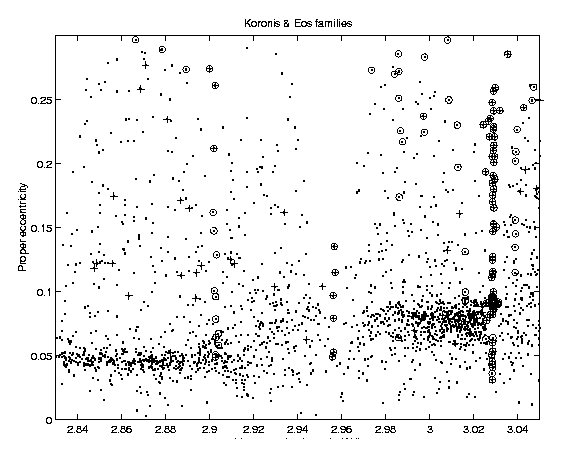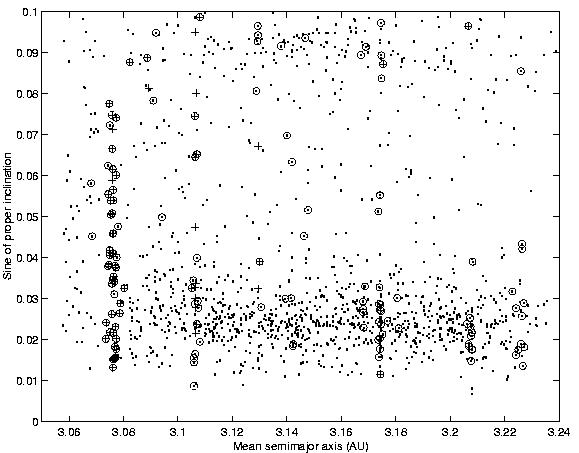


Next: 4. Conclusions
Up: 3. Results
Previous: 3.4 Global view of
3.5 Families
The new set of synthetic proper elements is accurate enough to enable
the study of the dynamical features of individual families. Such
studies have been conducted in the recent past (e.g. family of
Veritas; see Milani and Farinella [1994]; Milani et
al. [1997]; Knezevic and Jovanovic
[1997]; Nesvorný and Morbidelli [1998];
Knezevic [1999]) in the framework of dedicated
projects, but now one can recognize many interesting features by
simply looking at suitably prepared plots. Many of these features, so
far hidden and/or smeared out by proper elements not accurate enough,
became visible due to better resolution provided by new elements.
Figure:
The region of the Koronis and Eos
families. Dots stand for asteroids with good proper elements, crosses
are objects with large errors in proper eccentricity and inclination;
chaotic asteroids are marked with open circles - a dot inside the
circle indicates stable chaos cases with satisfactory proper
eccentricity and inclination, while a cross inside the circle
indicates that chaotic diffusion disturbed also eccentricity and
inclination.
 |
The chaotic orbits are included in the family envelopes as projected
on the ( )
space, for example, especially within the largest
families like Koronis, Eos and Themis, but also within the small,
compact ones, like Hygiea and Veritas. Mean motion resonances cross
the families giving rise to chaotic diffusion, and this causes the
family members to spill out from the regions occupied by the families,
mostly because of diffusion in the ep direction.. Thus, even if
genuine fragments belonging to the families (possibly formed billions
of years ago), they do not belong to the family cluster as they can be
identified with the present orbits. Such objects are crucial for the
studies of the post-formation dynamics of fragments and could be
counted in the family membership. On the other hand, they should not
be used for the reconstruction of the breakup relative velocity
fields, not to mix chaotic diffusion with relative velocities acquired
at breakup.
)
space, for example, especially within the largest
families like Koronis, Eos and Themis, but also within the small,
compact ones, like Hygiea and Veritas. Mean motion resonances cross
the families giving rise to chaotic diffusion, and this causes the
family members to spill out from the regions occupied by the families,
mostly because of diffusion in the ep direction.. Thus, even if
genuine fragments belonging to the families (possibly formed billions
of years ago), they do not belong to the family cluster as they can be
identified with the present orbits. Such objects are crucial for the
studies of the post-formation dynamics of fragments and could be
counted in the family membership. On the other hand, they should not
be used for the reconstruction of the breakup relative velocity
fields, not to mix chaotic diffusion with relative velocities acquired
at breakup.
Figure:
The region of the Themis and Hygiea
families. Dots stand for asteroids with good proper elements, crosses
are objects with large errors in proper eccentricity and inclination;
chaotic asteroids are marked with open circles.
 |
As an example we show on Figure 10 the region in the
(ap,ep) plane where the Koronis and Eos families are located. Some
alignments of chaotic objects, possible ex-members of the families,
along the resonant lines is clearly visible. The spillover from Koronis
family due to chaotic diffusion seems to be responsible for at least
part of the so-called Prometheus surge at  AU, while the 9:4
resonance affects Eos at
AU, while the 9:4
resonance affects Eos at  AU, with spillover both to higher
and lower eccentricities (compare with Morbidelli et al., [1995]).
Another example is shown in Figure 11, where the region
with
3.05<ap<3.24 AU and
AU, with spillover both to higher
and lower eccentricities (compare with Morbidelli et al., [1995]).
Another example is shown in Figure 11, where the region
with
3.05<ap<3.24 AU and
 contains the Themis and
Hygiea families and is crossed by several mean motion resonances. It
is clear that the spillover from the Themis family can extend a long
way.
contains the Themis and
Hygiea families and is crossed by several mean motion resonances. It
is clear that the spillover from the Themis family can extend a long
way.



Next: 4. Conclusions
Up: 3. Results
Previous: 3.4 Global view of
Andrea Milani
2000-10-03


